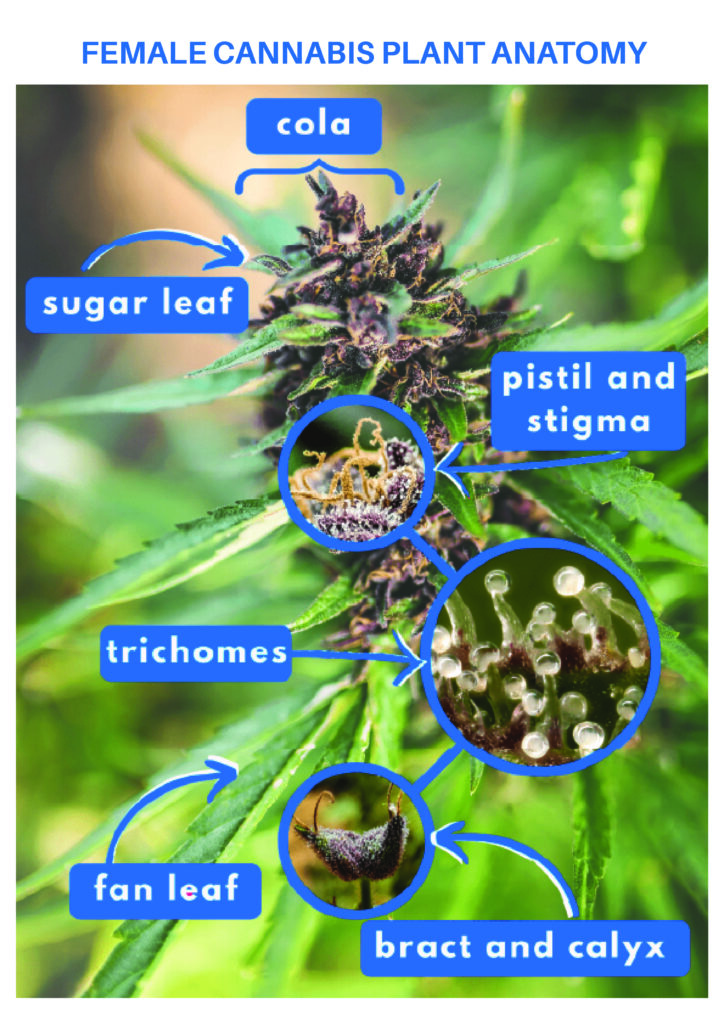The Cannabis Plant: Nature’s Gift Unveiled

Introduction
The cannabis plant, scientifically known as Cannabis sativa, has been a part of human history for millennia, revered for its versatility and medicinal properties. In this comprehensive blog, we will explore the fascinating anatomy, life cycle, pollination methods, defence mechanisms, habitats, and diverse types, shapes, and colours of the cannabis plant. Let’s embark on this journey of discovery and unravel the enigmatic world of cannabis.
Anatomy of the Cannabis Plant
The cannabis plant is a hardy, dioecious flowering plant, meaning it has separate male and female reproductive structures. Below is a simple table illustrating the basic anatomy of the cannabis plant:
| Plant Part | Function |
|---|---|
| Leaves | Photosynthesis and transpiration |
| Stems | Support, nutrient transport, and storage |
| Flowers (Buds) | Reproductive structures containing cannabinoids |
| Seeds | Reproduction and dispersal of the species |
| Roots | Anchoring, nutrient and water absorption |

1. Cola:
The Cola refers to the cluster of buds at the top of the female cannabis plant. It contains high concentrations of cannabinoids, such as THC and CBD, making it a crucial component for medical cannabis production. Colas are carefully cultivated and harvested for their therapeutic properties, contributing to the medicinal benefits of the plant.
2. Sugar Leaf:
Sugar Leaves are the small, sugar-coated leaves that surround the Cola and other buds. These leaves contain trichomes, which are resin-producing glands responsible for synthesising cannabinoids and terpenes. Sugar Leaves are also utilised in medical cannabis preparations due to their cannabinoid-rich content.
3. Pistil and Stigma:
Pistils and Stigmas are the reproductive structures of the female cannabis plant. The Pistil consists of the Stigma, which is a hair-like structure designed to capture pollen during pollination. While cannabis growers typically remove male plants to prevent seed development, these female reproductive components play a significant role in medical cannabis production as they are rich in cannabinoids and other beneficial compounds.
4. Trichomes:
Trichomes are tiny, crystal-like structures that cover the surface of cannabis plants, including the Cola and Sugar Leaves. These structures are the powerhouse of medicinal compounds, housing a majority of the cannabinoids and terpenes responsible for the therapeutic effects of medical cannabis. Trichomes are carefully preserved during harvesting to ensure maximum medicinal potency.
5. Fan Leaf:
Fan Leaves are the large, fan-shaped leaves that emerge from the cannabis plant’s branches. While they contain minimal cannabinoid content, they play a crucial role in the photosynthesis process, providing the plant with the energy it needs to produce therapeutic compounds. Fan Leaves also contribute to the overall health and vigour of the medical cannabis plant.
6. Bract and Calyx:
Bracts are modified leaves found at the base of each Cola, while Calyxes are small, cup-like structures that encase the cannabis seeds when pollinated. While Bracts and Calyxes have limited cannabinoid content, they are essential components for medical cannabis growers as they protect and support seed development, which is crucial for strain preservation and breeding purposes.
Life Cycle of the Cannabis Plant
The life cycle of the cannabis plant consists of several stages, each crucial for its survival and propagation. Let’s take a look at the key phases:
- Germination: The life cycle begins with a seed, which germinates when exposed to water, light, and suitable temperature conditions.
- Vegetative Stage: During this phase, the plant focuses on vegetative growth, producing leaves and stems. It requires ample light, nutrients, and water.
- Flowering Stage: As the plant matures, it enters the flowering stage. Female plants develop buds containing cannabinoids, while male plants produce pollen for pollination.
- Pollination: Cannabis plants employ various pollination methods, primarily wind pollination or insect-facilitated pollination.
- Seed Production: If pollination is successful, female plants produce seeds within their buds.
- Death and Decay: After seed production, the plant completes its life cycle and eventually dies or goes dormant.
Pollination Methods of the Cannabis Plant
The cannabis plant has developed different strategies for pollination. The two main methods are:
- Wind Pollination: In this method, male cannabis plants release pollen grains into the air, which are carried by the wind and may land on female flowers, leading to fertilisation and seed production.
- Insect-Facilitated Pollination: Some cannabis strains have co-evolved with insects like bees and butterflies to facilitate pollination. These insects visit male flowers, collect pollen, and transfer it to female flowers, aiding in fertilisation.
Defence Mechanisms of the Cannabis Plant
To protect itself from predators and environmental stressors, the cannabis plant deploys various defence mechanisms. These include:
- Cannabinoids: Cannabis plants produce a range of cannabinoids, including THC and CBD, which can deter herbivores and insects.
- Trichomes: Tiny hair-like structures on the surface of cannabis leaves and buds secrete resin, which contains cannabinoids and terpenes that can repel pests.
- Smell: The strong aroma produced by cannabis plants can attract pollinators and beneficial insects while repelling potential threats.
- Adaptability: Cannabis plants can adjust their growth patterns and chemistry in response to environmental conditions, enabling them to survive in various habitats.
Habitats of the Cannabis Plant
The cannabis plant is remarkably adaptable and can thrive in diverse habitats, including:
- Outdoor Environments: Cannabis grows well in temperate climates with long growing seasons, such as parts of North America, Europe, and Asia.
- Indoor Cultivation: Controlled indoor environments with appropriate lighting, temperature, and humidity can also support cannabis growth.
- Greenhouses: Greenhouses offer a balance between outdoor and indoor cultivation, providing a controlled environment with natural light.
Various Types, Shapes, and Colours of Cannabis
Cannabis exhibits a wide array of types, shapes, and colours, influenced by factors such as genetics, cultivation techniques, and environmental conditions. Below are some common cannabis types:
| Type | Shape | Colour |
|---|---|---|
| Sativa | Tall, slender | Light green, orange, yellow |
| Indica | Short, bushy | Dark green, purple |
| Ruderalis | Small and rugged | Pale green |
| Hybrids | Varies depending on mix | Combination of colours |
Conclusion
The cannabis plant is a remarkable botanical wonder, with a rich history and countless applications in various fields. Understanding its anatomy, life cycle, pollination methods, defence mechanisms, habitats, and diverse characteristics can foster appreciation for this extraordinary plant. Whether it’s for medical purposes, recreational use, or industrial applications, the cannabis plant continues to intrigue and amaze humanity, reminding us of the wonders of nature.
Disclaimer:
This post aims to provide general information about the cannabis plant. Cultivation, possession, and use of cannabis is illegal without the correct authorisation Always abide by the laws and regulations put in place. Consult a qualified professional for personalised advice related to medical cannabis.
The Cannabis Plant: Nature’s Gift Unveiled Read More »
